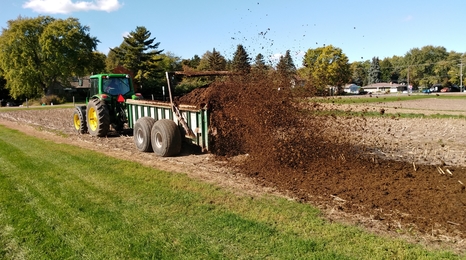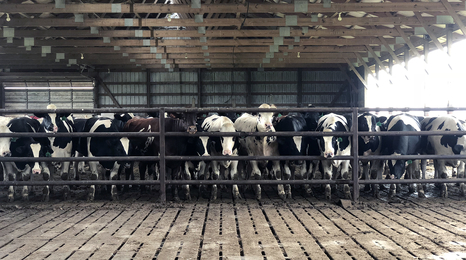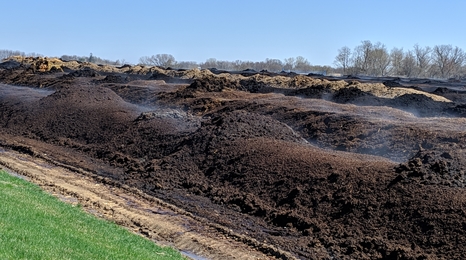Manure management
Best management practices to safely apply, sample and analyze manure to protect air and water quality.
Air and water quality
Advice for managing manure while reducing air and water quality issues includes:
- Information about managing animals near shoreline.
- Best management practices for pathogen control in manure.
- OFFSET and MinnFARM tools for odor and runoff management.
Tips to reduce water quality issues
- Managing water contamination.
- How nitrogen, phosphorus and pathogens contribute to pollution.
BMPs for pathogen control in manure
- Examples of pathogens found in manure.
- Examples of human disease outbreaks caused by manure.
- Main areas of focus for reducing pathogens.
Managing crops and animals near shoreland
- Sources of nonpoint pollution in Minnesota.
- Major agricultural pollutants.
- BMPs to prevent nonpoint source pollution.
- Regulations that apply.
When discussing odor problems related to animal agriculture, the following questions often arise:
- How far does odor travel?
- Are animal numbers or animal species accurate predictors of nuisance odors?
- How much odor control is needed to solve an odor problem from an existing facility?
This tool, developed at the University of Minnesota, helps answer some of these questions.
- Odor from feedlots setback estimation tool (OFFSET)
- Or, use the metric version of OFFSET
- OFFSET user's guide and worksheet
The tool is the result of four years of extensive data collection and field testing. It is designed to help answer the most basic questions about odor impacts from livestock and poultry facilities.
OFFSET estimates average odor impacts from a variety of animal facilities and manure storages. These estimations are useful for rural land use planners, farmers or citizens concerned about the odor impact of existing, expanding or new animal production sites.
OFFSET is based on odor measurements from Minnesota farms and Minnesota climatic conditions. Consult with the tool authors before using OFFSET for estimating odor impacts in other geographic areas.
The Minnesota Feedlot Annualized runoff model (MinnFARM) is an evaluation system to estimate annual pollutant and prioritize feedlot pollution potential.
The Minnesota Department of Agriculture (MDA) has teamed up with the National Weather Service to design a tool that helps farmers and commercial applicators determine the best time to apply manure.
The Runoff Risk Advisory Forecast tool uses past and predicted National Weather Service weather data like precipitation, temperature, and snow melt.
It predicts the likelihood that applied manure will run off fields in daily, next day, and 72 hour increments. Farmers and commercial applicators use an interactive map to locate their field and find the forecasted risk.
Land application
- Manure characteristics.
- Timing.
- Application methods.
- Sampling and nutrient analysis.
- Application rates.
- Estimating manure value.
- Preventing nitrogen loss.
Manure characteristics, timing, application methods, sampling and nutrient analysis and application rates.
-
How to determine nutrient content based on animal species, diet, housing, bedding, manure storage and water dilution.
-
Information about nutrient availability in manure, especially nitrogen, phosphorus and potassium.
Application methods and nitrogen loss
-
A guide to making manure applications while mitigating nitrogen loss.
-
Information about nitrogen loss based on broadcast vs. broadcast with incorporation.
-
A look at different injection application methods: knife injection, sweep injection and disk or coulter injection.
-
Information on manure application timing and its impact on nutrients.
-
Pros and cons of application per season.
Manure sampling and nutrient analysis
-
Why analyze manure?
-
Information on manure uniformity.
-
How to sample manure for nutrient analysis.
-
Sampling methods for liquid or semi-solid manure.
-
Understanding manure analysis output.
Manure application rate guidelines
- Information on nitrogen and phosphorus guidelines for manure for various crops.
- How the guidelines are determined.
Calculating manure application rates
-
A step-by-step guide to calculating manure application rates for nitrogen and phosphorus.
- What’s manure worth?
Manure can supply nutrients for crops, which offsets the need to buy commercial fertilizers
Here’s a look into how we calculate the value of manure
- Manure value calculator
Use this calculator to find the value of manure on your farm
Recommended Methods of Manure Analysis
Standardized methods for sampling, processing, and analysis of mineral constituents of livestock manure samples for agricultural and horticultural use
Use this manure laboratory analyses aggregating tool to utilize data in a standardized way
Safety
Learn how to manage manure safely.
- How to safely agitate and pump manure.
- How to prevent and manage manure spills.
Manure spill prevention and management
- Environmental impacts
- Preventing spills from manure storage, transportation and land application
- Managing manure spills
Farm Safety Checklist: Manure Application
- Keep this safety checklist in mind for agitation, pumping, transportation, and application.
Manure gas dangers during liquid manure agitation and pumping
- As organic material in the manure breaks down, the lack of oxygen in the manure liquid promotes hydrogen sulfide, methane and other gas formation.
- Methane is a fire/explosion hazard when it reaches flammable limits of 5 to 15 percent by volume.
Protocols and preparation for manure agitation and pumping
- Each farm should have safety protocols for manure storage systems.
- All on-farm family and staff should be aware of the dangers of manure gas exposure, and how to reduce the risks to human and animal health and safety.
Courses and events
Commercial Animal Waste Technician (CAWT) workshops
Re-certify as an MDA Commercial Animal Waste Technician (CAWT) by attending one of these workshops. Held annually in the winter.
Manure Management Planning in Minnesota virtual course
Are you in interested in learning how to use the Manure Management Planner from the Minnesota Pollution Control Agency? This course explores the science behind manure management planning in Minnesota.
Manure composting workshops
UMN and NDSU Extension programs along with compost producers in each state team up to offer online manure composting workshop for crop and livestock producers, people interested in composting, technical service providers and educators. Check back here in the summer for upcoming workshops.




